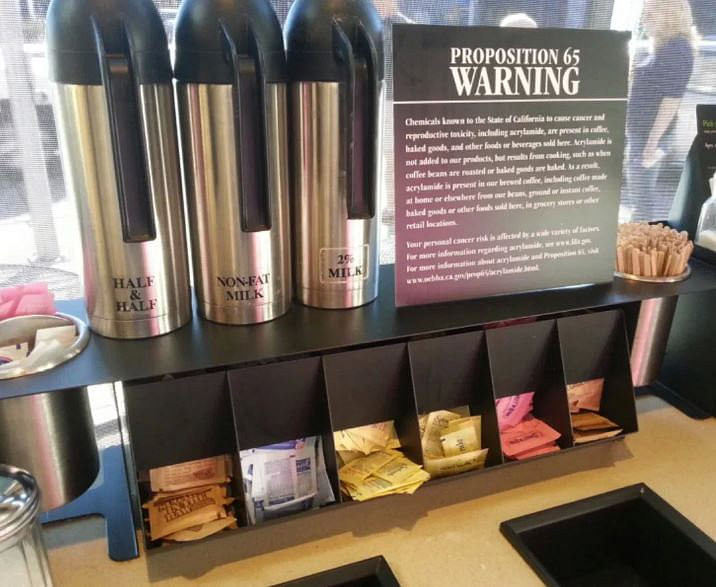Nov 11th, 2020
The Pros and Cons of California’s Proposition 65: Ensuring Safe Drinking Water

By: Jennifer F. Novak
Our November 2020 Newsletter Article
Proposition 65, California’s Safe Drinking Water and Toxic Enforcement Act of 1986 was developed based on good intentions. The general goal was to protect the state’s potable water sources from being contaminated by chemicals that are known to cause birth defects, reproductive health issues, or cancer. The theory is that when consumers know about a potential health threat they can make better-informed decisions about their exposure to that threat.
However, an unanticipated outcome is that the warnings might not be doing much to keep us safe—the chemicals in question are found in many common products purchased every day, or they are released into the environment on a regular basis. In the past 30+ years, the State of California has developed a list of chemicals known to cause cancer or affect reproductive health. That list now contains more than 900 chemicals that fall under the Proposition 65 requirements.
This has turned Prop 65 into a burden, perhaps even equal to its benefit.
When Is A Proposition 65 Warning Mandated?
If a business knows or believes it is exposing people to a listed chemical, it must post a warning on its product label or conspicuous notice in the location where the exposure is occurring. For example, if a rental management company knows one of its housing complexes has a listed chemical on the premises, it must post a warning for the tenants.
What The Warnings Actually Say
Proposition 65 warnings mean the business in control of that product or location knows or believes that the product or location is exposing you to one or more chemicals found on the list. What the warning does not tell you is which chemical or chemicals are present, how much of the chemicals are present, or what specific amount of a chemical is harmful. In other words, the warning only tells you that a listed chemical is present, nothing more.
Enforcing Proposition 65
The government may bring a claim against an alleged Proposition 65 violator as well as other entities or individuals acting on behalf of the public welfare. For example, consumer advocate groups, private citizens, and law firms can bring suit to protect those alleging injury. These lawsuits cannot be taken lightly. A business found in violation of Proposition 65 could face daily fines as high as $2,500.
Proposition 65 Pros
Proponents of this Act believe these regulations offer effective protection. Numerous plaintiffs have brought successful lawsuits under Prop. 65. The Act has resulted in modifications of children’s products and some foods that make them safer for the consumer and have even allowed the business to no longer have to post warnings. It incentivizes businesses to be proactive in keeping their customers safe, and empowers customers to be able to know when there might be a problem.
Proposition 65 Cons
A general criticism is that the warning requirements are unnecessary and expensive burdens, especially for smaller businesses, when compared to the possible public health benefit. Critics point out that Californians see warnings everywhere including stores, hospitals, parking lots, and most public buildings. Because of their overuse and generality in nature, warnings become meaningless and consumers ignore more significant dangers that get lost in the plethora of warnings.
Litigation is a concern because anyone can bring a lawsuit even if the chemical content is well below the level that would cause a detrimental effect. The legal burden is on the defendant to prove the product is not covered by Proposition 65. This is an extremely expensive process. Because they have the legal burden under the current rules, defendants often settle these cases even when they are not liable, just to avoid the expense of litigation.
To avoid litigation and the associated costs, a company may issue a warning even if the level of the chemical in its product may be insignificant. As a result, the presence of a chemical warning may deter potential buyers because of a threat that doesn’t exist.
Success Or Failure?
Based upon state health statistics, economists have concluded that these regulations have had no impact on California’s cancer rates, and no empirical study shows any public health benefits. One suggestion is to shift the burden of proof so that plaintiffs bear the cost of proving chemical exposures instead of defendants having to show no detrimental effect. This would discourage frivolous lawsuits that force businesses to settle rather than litigate in order to save money.
Does Proposition 65 Impact You?
The OEHHA (California Office of Environmental Health Hazard Assessment) has adopted safe harbor levels (levels of exposure that trigger the warning requirement) for some of the listed chemicals. If your business creates exposures higher than the safe harbor level you must comply with Proposition 65.
If no safe harbor level is provided, and your business exposes people to a listed chemical, you are required to give a warning unless you can show the expected exposure is not a significant risk of cancer or reproductive harm. The cost to determine the risk level of exposure can be enormous.
Depending on your business and the chemicals you use, we recommend reviewing the Proposition 65 list to determine whether your business is likely to expose individuals to any listed chemicals. You should consider consulting a qualified professional if you believe your business may fall underProposition 65.